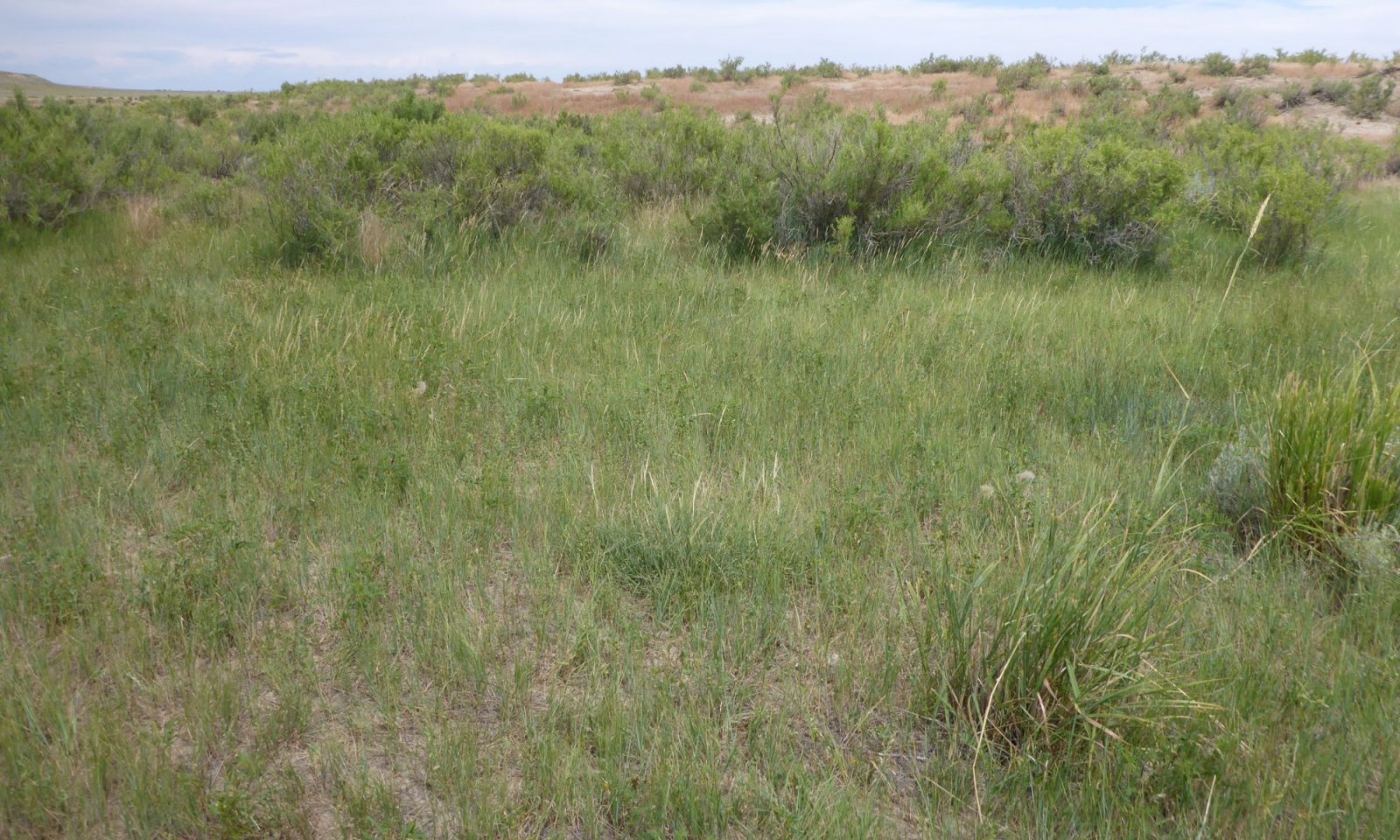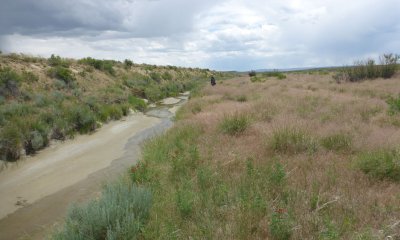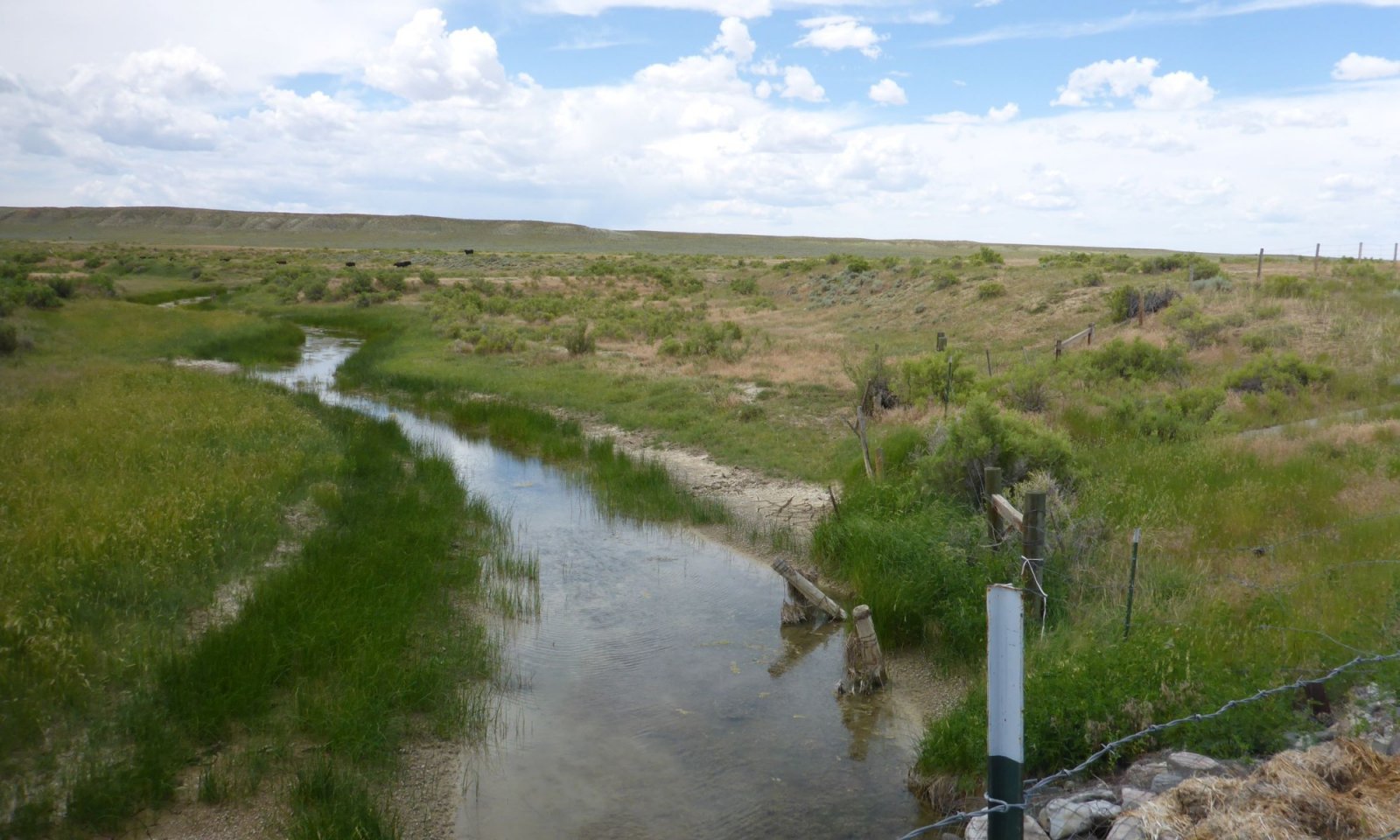
Saline Lowland (SL) Wind River Basin Wet
Scenario model
Current ecosystem state
Select a state
Management practices/drivers
Select a transition or restoration pathway
-
Transition T1-2
Frequent and severe grazing with no overflow will convert this plant community to the Dense Shrub/Bare Ground Sod Plant Community. Prolonged Drought will exacerbate this
More details
transition. -
Transition T1-3
Frequent and severe grazing with brush management will convert this plant community to the Inland Saltgrass Sod Vegetation State.
More details -
Restoration pathway R2-1
Brush management to reduce shrub cover, prescribed grazing, and potentially seeding, assists the recovery of this State.
More details -
Transition T2-3
Brush management with prescribed grazing, potentially long-term prescribed grazing, will result in the Sod-bound State.
More details -
Transition T2-4
Continued disturbance with a seed source present allows invasive species to establish and become dominant in a community.
More details -
Transition T3-4
Ground disturbance and drought provides opportunity for invasive species to establish within the community when seed sources are present.
More details -
Restoration pathway R4-5
Weed control, mechanical preparation and seeding of improved varieties with prescribed grazing will aid to improve this community to the Altered State.
More details -
Transition T5-4
Lack of weed control or management, seeding failure, or continued disturbance will allow an Altered State to become an Invaded State.
More details -
No transition or restoration pathway between the selected states has been described
Target ecosystem state
Select a state
State 1
Reference



Description
The Reference State of the Saline Lowland ecological site is the native community phases that have historically populated the flood plains of ephemeral and perennial drainages. The community relies on the overland flows/flooding from spring runoff and large precipitation events as well as woody species are utilizing the water table (generally deeper than herbaceous root systems).
Characteristics and indicators
Alkali sacaton and basin wildrye are major components to the community with greasewood as a minor but distinct cover component (less than 15 percent). Bare ground is minimal, with only small interspaces between vegetative cover. A mixture of tall- and mid-stature grasses both warm and cool-season, with a scattering of forbs is key to the Reference State.
Resilience management
The Reference State is diverse in plant composition providing flexibility in responses to fluctuating water tables and drought conditions. This resiliency of the community, however, is limited by the dependency on the fluctuating water table. Once altered, the communities have little resistance to change.
Submodel
Description
The Shrub Dominated State is a greasewood community with significant extents of bare ground and potential for weedy annuals. Rubber rabbitbrush and basin big sagebrush are also common members of this community.
Characteristics and indicators
Greasewood, or a combination of shrubs, will form a significant (greater than 15 percent) cover within the community. Few perennial grasses are present in the community. Those that are able to persist generally are found within the basal cover of the greasewood or other shrub cover. Bare ground is often extensive, comprising between 30 to 50% of the cover. Weedy annuals such as mustards, six-weeks fescue, and annual wheatgrass will often provide some cover in these interspaces. Often, evidence of wind scour and other erosional patterns are present in the interspaces between greasewood.
Resilience management
The shrub cover and exposed salty soils limit the ability for seedling establishment. However, greasewood is persistent even with intensive use. The community is resilient, but is not resistant to invasive by non-native, noxious weeds.
Submodel
Description
The tillering, mat-forming nature of inland saltgrass forms a sod-bound community that hinders water movement into the soil profile and hinders other native species from establishing or persisting in the community. As the tall- and mid-stature grasses are removed from the community, the short-stature sod-forming grasses increase to stabilize the community.
Characteristics and indicators
Remnants of alkali sacaton will persist with a few less desirable species (little barley, foxtail barley, Baltic rush). Greasewood is generally present, but more scattered across the community.
Resilience management
The dense, tightly rooted sod-forming species are resistant to hoof impact and traffic, as well as drought tolerant. This combination makes for a resilient community with continued disturbances.
Submodel
Description
Deterioration of the reference community opens the soil to invasion by undesirable species. Migration of wildlife, use by livestock, and water flow events provide seed sources to encourage invasive species to establish in the disturbed communities. This disturbance with a seed source present is what allows establishment to a significant level to occur.
Characteristics and indicators
When the community is comprised of five percent or greater of invasive (non-native) species, the threshold has been crossed into the Invaded State. Cheatgrass, salt cedar, and Russian Olive are among potential species of invasion; however, whitetop, knapweeds, and thistle are also prevalent.
Resilience management
The inability to eradicate cheatgrass, and the challenges to maintain high levels of weed control limit the ability for this State to improve, making it resistant to change. The ability for the invasive species to adapt and recover following disturbance make this state resilient.
Submodel
Description
Mining, energy development, irrigation conveyance lines, irrigation, and livestock operating facilities are a few activities that have created a change to this ecological site. The soil disturbance, removal of greasewood and other vegetation, as well as impacts to they hydrology of this ecological site has left scars on the landscape.
Characteristics and indicators
Outside of the visible evidence of soil movement, seeding, or development the altered/disturbed community is comprised of non-native or improved varieties and varying successional species such as weedy annuals (Russian thistle, sunflower or other asters) and foxtail barley.
Resilience management
Frequency of disturbance, species established, level of management, and remaining hydrology determines the resistance and resiliency of the Altered State.
Submodel
Mechanism
Repeated frequent and severe grazing, especially year-long or continuous, will weaken the herbaceous cover. Frequent years with reduced or no overflow will convert this plant community to the Dense Shrub/Bare Ground Sod Community phase. Prolonged Drought will exacerbate this transition. The lack of extra effective moisture and the lack of recovery time for the perennial grasses remove them from the community and allow greasewood and rubber rabbitbrush to persist.
Constraints to recovery
The harsh environment created by salt-laden soils and the potential for compaction limits the ability for grasses and other herbaceous species to establish. The droughty conditions that created the transition also limit seedling establishment. Over time, the lack of seed-source for desired perennial grasses becomes scarce further limiting the ability for the community to recover.
Mechanism
Frequent and severe grazing with brush management or disturbance to brush cover will convert this plant community to the Sod Bound State. The loss of overflow conditions or high traffic aids in this conversion.
Constraints to recovery
The competitive nature of inland saltgrass and its tillering root structure limits the ability for other native species to propagate and compete in these communities.
Mechanism
Grazing land mechanical treatment (chiseling, etc.) and brush management followed by
prescribed grazing and if necessary seeding will return this plant community to near Reference. Return of overflow conditions and restored water table assists with recovery of this site as well. The time required for a transition will be determined by climatic factors and seed sources present.
Context dependence
Extent of soil disturbance determines if the site is able to move towards the Reference State, or if hydrology and soils are altered enough that the site becomes disturbed or the Altered State.
Relevant conservation practices
| Practice | External resources |
|---|---|
|
Brush Management |
|
|
Critical Area Planting |
|
|
Stream Habitat Improvement and Management |
|
|
Grade Stabilization Structure |
|
|
Prescribed Grazing |
|
|
Grazing Land Mechanical Treatment |
|
|
Range Planting |
|
|
Heavy Use Area Protection |
Mechanism
Mechanical disturbance to eradicate or reduce the cover of greasewood and other woody species, while providing opportunity for resilient species to establish with prescribed grazing and time, helps this site to transition to the Sod-Bound State. Disease, drought, and other disturbances are also responsible for the removal of shrub cover that will also allow inland saltgrass to establish, when it is prominent in the understory or seedbank.
Constraints to recovery
The nature of tillering plants, i.e. inland saltgrass, restrict other native grasses and forbs from establishing in the community. This cover is also restrictive to shrub recovery. Recovery to Reference is highly unlikely due to the lack of key species and the restrictive nature of the sod cover. The removal of the sod cover is highly unlikely to occur without major disturbance that would alter the function of the site, transitioning to the Altered State.
Mechanism
The open nature of the Shrub Dominated State provides opportunity for invasive species to gain a foothold in a community. The lack of ground cover, and the on-going disturbances in this state provide a seed-source as well as seed-soil contact to encourage establishment. Livestock and wildlife movement through the site, human traffic, as well as wind and water aid in providing seed sources.
Constraints to recovery
Once most invasive species establish in a community, on going disturbances, encourage further spread and prominence. The difficulty to control, let alone eradicate, most invasive species limits the potential for recovery once a community becomes invaded.
Mechanism
Ground disturbance and drought assist to weaken inland saltgrass, providing opportunity for invasive species to establish. Traffic, human and animal, as well as wind and water provide seed sources for invasive species to the community.
Constraints to recovery
The challenge to control (maintain) or eradicate invasive species is the major constraint to the recovery from this transition.
Mechanism
An integrated approach, generally including chemical treatment of invasive species, mechanical working of the soil and seeding or planting native or improved varieties to provide perennial cover of desirable species is applied to improve this community. Continued weed or integrated pest control as well as grazing management is needed to prevent further regression or invasion of the site.
Context dependence
The extent of treatment and necessary procedures will be determined by the exact species of invasion within the community, the accessibility of the community, and native species remaining in the community.
Relevant conservation practices
| Practice | External resources |
|---|---|
|
Brush Management |
|
|
Critical Area Planting |
|
|
Stream Habitat Improvement and Management |
|
|
Grade Stabilization Structure |
|
|
Prescribed Grazing |
|
|
Grazing Land Mechanical Treatment |
|
|
Range Planting |
|
|
Heavy Use Area Protection |
|
|
Integrated Pest Management (IPM) |
|
|
Early Successional Habitat Development/Management |
Mechanism
Seeding failure or lack of management following seeding are common mechanisms that allow for the re-establishment or establishment of weeding species in an altered community. Continued disturbance or new disturbances to a community provide opportunity for new or reoccurring invasion.
Constraints to recovery
Weed control is the limiting factor to recovery for this site.
Model keys
Briefcase
Add ecological sites and Major Land Resource Areas to your briefcase by clicking on the briefcase (![]() ) icon wherever it occurs. Drag and drop items to reorder. Cookies are used to store briefcase items between browsing sessions. Because of this, the number of items that can be added to your briefcase is limited, and briefcase items added on one device and browser cannot be accessed from another device or browser. Users who do not wish to place cookies on their devices should not use the briefcase tool. Briefcase cookies serve no other purpose than described here and are deleted whenever browsing history is cleared.
) icon wherever it occurs. Drag and drop items to reorder. Cookies are used to store briefcase items between browsing sessions. Because of this, the number of items that can be added to your briefcase is limited, and briefcase items added on one device and browser cannot be accessed from another device or browser. Users who do not wish to place cookies on their devices should not use the briefcase tool. Briefcase cookies serve no other purpose than described here and are deleted whenever browsing history is cleared.
Ecological sites
Major Land Resource Areas
The Ecosystem Dynamics Interpretive Tool is an information system framework developed by the USDA-ARS Jornada Experimental Range, USDA Natural Resources Conservation Service, and New Mexico State University.




